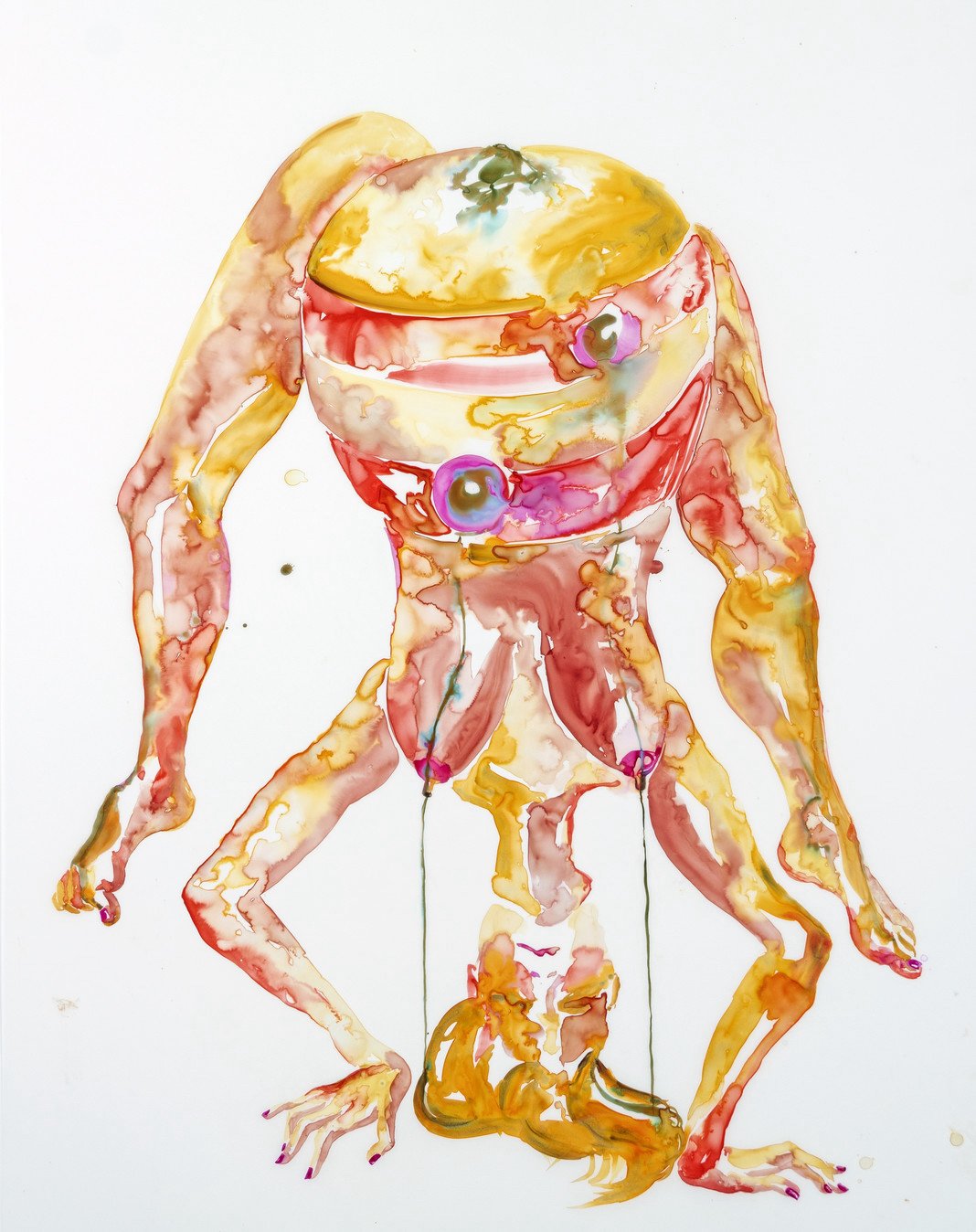Portfolio: Alexandra Carter
The Mother Shell, 2023, ink on drafting film, 17 x 14 in.
[Image description: A woman cradles a child, the lower part of her body morphing into a shell.]
In her series titled The Mother Shell, artist Alexandra Carter draws on bits of her own identity and past to construct paintings that explore what it means to be a woman and how that identity is separate from, but affected by, her identity as a mother.
In The Mother Shell (2023), Carter uses ink on drafting film to create a bright, warm image of a mother holding her child to her chest. The artist employs yellows, reds, and browns that pool and blend together to enhance the fluidity of the mother’s body, which morphs into a shell-like shape below her waist. She transforms into a protective shell, sheltering and nurturing her child, serving as a loving mother as well as a vessel for growth. This theme of mother-child relationships is present throughout the series, and Carter’s work embodies the joys and tribulations of this dynamic.
Viability, 2023, ink on drafting film, 66 x 42 in.
[Image description: A woman’s head and arm surrounded by amorphous shapes.]
Whereas The Mother Shell highlights the protective and nurturing nature of a mother, Viability (2023) emphasizes the obstacles that can come along with pregnancy. Viability combines blues, yellows, browns, and a touch of red to create a billowing mass of abstracted form. The head and arm of a woman are visible, and she grasps an amorphous shape, whose small arms suggest that it is her child. Pools of thin, colored ink surround the figures, crafting an energy that pulses from their connection. The title of this piece offers a hint about its meaning: “Viability,” as in the chance of a fetus’s survival, but also, more generally, as in the ability of any of us to live successfully. After dealing with pregnancy loss and struggling with infertility, Carter became very familiar with the word “viability” in the context of her pregnancy and her role as a mother. Carter has remarked that because she was able to have a child after a long struggle with infertility, she felt as if she should be relentlessly grateful for all that she had, and thus felt guilty when she became frustrated or overwhelmed with her motherly duties. Through Carter’s journey as a mother, she has come to learn that it’s not only acceptable to feel both the negative and positive emotions that come with parenting, but that this array of feelings creates the uniquely human experience filled with joy and sorrow, pain and promise. The emotions that this piece stimulates are manifold, evoking security and gratitude, but also drawing attention to just how much a mother gives, and how that act of giving is often accompanied by sacrifice. Nevertheless, Viability shows that the precious connection between mother and child is not lost through this sacrifice—rather, it remains vital.
Nonstress Test, 2021, ink on drafting film, 59 x 42 in.
[Image description: A woman balancing upside-down on her hands and head.]
Nonstress Test (2021) examines the biological role many women play when they become mothers. In this work, yellow, red, and pink inks make up the form of a woman. She is positioned upside-down, supporting herself on her head and hands, while her limbs are unnaturally contorted and green liquid streams from her body into her hair, which pools on the floor. Most notably, Carter has placed a jar-like shape where the woman’s uterus might typically be. This choice frames the mother as a biological container for new life. Many women, the work suggests, are often faced with a sense of biological duty to produce children. This obligation is formed through the societal idea that a woman’s power and worth comes from her ability to create life–while this is indeed an incredible power that should not be understated, it is not, the artist argues, the basis of a woman’s worth.
Carter’s work proposes that, like all identities, a woman’s identity is complex and multi-faceted. The trials that can arise from being a woman are often difficult and painful, but such a dynamic is, ultimately, the beauty of being human
—Ciara Colgan, HereIn Intern



